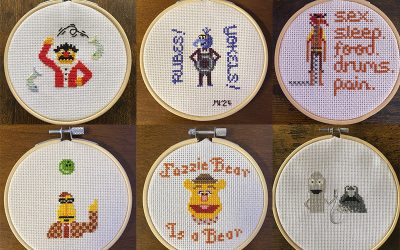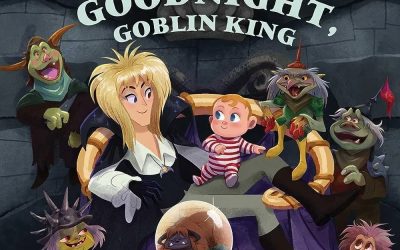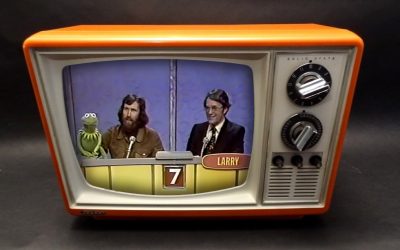Continuing our Q&A with Muppet writer, Jim Henson Legacy president, and Muppets Character Encyclopedia author Craig Shemin. Don’t forget to read Part 1 and Part 2!
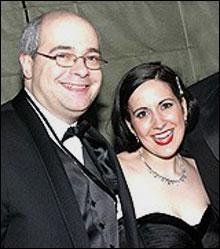 TP: So, you and Stephanie D’Abruzzo are like the Muppet power couple. How did you guys meet, and how do you balance your Muppet work life with your non-Muppet personal life? If there’s such a thing as your non-Muppet personal life.
TP: So, you and Stephanie D’Abruzzo are like the Muppet power couple. How did you guys meet, and how do you balance your Muppet work life with your non-Muppet personal life? If there’s such a thing as your non-Muppet personal life.
CS: We both went to Northwestern University, but we weren’t there at the same time. I graduated, and I was back visiting campus, and a friend of mine was having a party, and he invited Stephanie because she was into puppets, and a big Muppet fan. I met her then — she was just a kid! She was really interesting, and we talked a lot about Muppets.
They were putting one of the Art of the Muppets exhibits at the Museum of Science and Industry. This was in ’92 or so. I was helping in the research of The Works book, so one of my jobs was to take the designers of The Works book to Chicago, show them the exhibit, and give them information.
Then I hear from her later on, that she had done a puppet video production that won a Student Emmy award. We had kept in touch a little bit, and then David Rudman’s wife saw a little blurb about Stephanie’s award in the Chicago Tribune: “Puppet video wins Student Emmy.” David’s wife showed it to David, David went out to campus, and he met with her and invited her to audition for Muppets.
She took the train in, and auditioned when they were trying very hard to find female performers. We had dinner when she was here, because I was the only one she knew in New York. She kept getting called back, and she was running out of money to stay at the youth hostel.
It was a Friday, and they had called her back for Monday, because that’s when the Sesame executives were coming in, and she called me, and she was like, “I don’t know if I should stay.” I said, “Well, do you need a place to stay? You can come and stay at my place.” So she did, and we started hitting it off, and she came back for a big “Muppet Institute of Technology” month-long workshop. She stayed with me then, and neither of us wanted her to leave. And we’ve been together ever since.
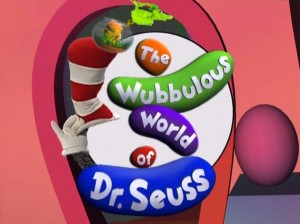 What’s interesting is that we don’t work together a lot. We worked on Seuss together, and it was a really good experience, because it was a very new experience for both of us. It was her first big principal role in a Henson project, and it was my first big job doing full-length scripts for Henson. We were having a great time, and neither of us had a lot of authority to push the other one around, so it was a good thing.
What’s interesting is that we don’t work together a lot. We worked on Seuss together, and it was a really good experience, because it was a very new experience for both of us. It was her first big principal role in a Henson project, and it was my first big job doing full-length scripts for Henson. We were having a great time, and neither of us had a lot of authority to push the other one around, so it was a good thing.
I wanted to be a puppeteer when I first started, but looking back I’m glad I didn’t pursue that route, because two puppeteers in a household may be challenging. But we have a great time, and we try and support each other, and she read everything that I did for the encyclopedia before it went in, and I try and support her as much as I can with her work. We try and do some stuff together too, but not as much as we would like.
TP: What was the last you worked on together?
CS: We did Oobi together for Josh Selig. We do a lot of little personal projects that we’ll work on together.
TP: You guys do some short videos together, like the Jerry Nelson tribute.
CS: She’s been a lot of help with editing the compilations. She doesn’t really want or take a lot of credit, but I’ve been putting her name on the credits recently because she does a lot of what we call the “fine cutting.” Sometimes when you’re really close to something, it’s hard to take that razor blade and cut that two-minute thing that you really need to cut to get it done in time. She and I work on that stuff a lot together.
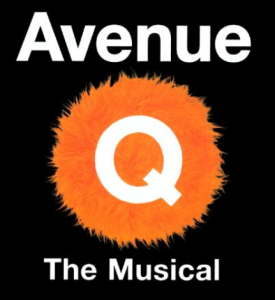 TP: Muppet Wiki says you contributed to an early version of Avenue Q.
TP: Muppet Wiki says you contributed to an early version of Avenue Q.
CS: I did, yes. In the beginning, they wanted to do it as a television show. Avenue Q they saw as sort of a puppet South Park. I met the guys because they came in to pitch “Kermit, Prince of Denmark.” I heard it, and I’m like, “The music’s good, but guys, it’s Hamlet. Doesn’t everybody die?” Jeff [Marx] and Bobby [Lopez], who wrote it, they’re like, “Well, yeah, but we’ve changed it so they don’t die.” And I said, “Well, then you’re not doing Hamlet, are you? Why not do something like Taming of the Shrew, where no one has to die?”
Then they said, “We have this other thing that we’re working on,” and we went into the second-floor conference room, and they played me some of the early tunes for Avenue Q. I was like, “Now this is something.” They told me what their concept was, and they also mentioned that they were planning to do a reading, and that’s when they said they needed a female puppeteer. And I said, “I just happen to know one!”
TP: So you were actually involved before Stephanie was?
CS: Well, I knew about it before she did. I think Rick Lyon also recommended her at the same time. She got together with them, and they were getting ready to do this reading of some of their sketches and scenes, and Stephanie brought home the script and showed me. She was like, “The music’s real good, but you gotta look at some of this stuff.”
I called the guys and I said, “Some of this stuff, the sketches aren’t working. You don’t really have endings, and the characters are really solid…” At first they were like, “Well, we’re pretty happy with what we have.” Then they called me back the same night and said, “What would you do?” They were going to be doing their reading very shortly after. I said, “Give me a few hours, and I’ll show you what I would do,” and I sent them the thing. They were very resistant at first, and then I said, “You have a reading tomorrow, guys. Read my version of this at the table read and see what happens.” So they did it, and people started laughing, at it went over well, so they said, “I think we should keep all this stuff.”
Then I was involved in a couple of versions in the first full-length. They had some producers come to the reading who had urged them to do it as a stage show. A lot of us thought it would be a better stage show. I thought it would get old as a television show, after a while. The producers that wanted to work with them wanted to get a writer that was more from the theater world than the television world.
TP: So that’s when you were done.
CS: Yes. Stephanie was not very happy about it. She wanted to leave the show at that point, and I said, “Don’t leave the show. There’s no show yet. See what happens,” and I’m glad that she didn’t.
TP: Did you write anything that made it into the stage show?
CS: No, because I basically told them that they could have what I did if I could have the royalty to go with it, and they were very hesitant to offer up anything. So I said, “Well, then you can’t use anything.” Fortunately, I had someone with access to the rehearsals who would be able to make sure that they weren’t using anything. She would come home and say, “You know, they’re starting to do this thing…” so I would write them, and they’re like, “Okay!”
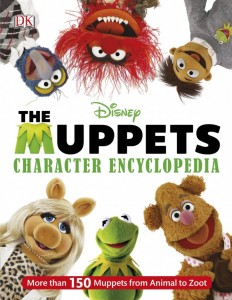 TP: Let’s talk about The Muppets Character Encyclopedia. And it is the “Muppets” Character Encyclopedia. Everything has to be “Muppets” now — it can’t be “Muppet?”
TP: Let’s talk about The Muppets Character Encyclopedia. And it is the “Muppets” Character Encyclopedia. Everything has to be “Muppets” now — it can’t be “Muppet?”
CS: “Muppets” is the group. That is sort of the general accepted style that Disney does. Also, what’s very interesting — I don’t know when they did it, it was some sort of legal move, and this is across all of the Disney properties — if you notice, it says “Disney.” Years ago, it used to say “Disney’s.” That was a move that was across all the packaging, so I think there was some sort of change in using the possessive. I never was able to get anyone in legal to explain why. I think “The Muppets” is what they call the franchise.
TP: It just sounds grammatically incorrect. You wouldn’t say “The Muppets Show.” But the app is called “My Muppets Show.”
CS: Well, people who do the branding and the legal stuff are seldom thinking about that.
TP: As long as they don’t retroactively change the names of the old stuff.
CS: A few years ago, they went about changing the characters internationally, so they would match. It used to be that Kermit was “Rene” in France, but now I believe he’s Kermit again. I think it’s all about trying to maintain a clear, matching system across all the media and all the locations. “Worldwide domination,” I think, is what we call it.
TP: How did the book come about?
CS: I get a call from Jim Lewis, and he basically said that DK is planning on doing this book. He asked me if I wanted to do it — he was going to be involved as a consultant, but he either didn’t want to write the book or didn’t have time to write the book, but he thought that I would do a good job of it. DK then followed up, and it happened very quickly.
TP: How long ago did it start?
CS: It was during the summer.
TP: That is very quickly!
CS: I started working on it, I think, in July. I started the paperwork in June, and then I started working on it in July. I actually didn’t have a contract until September, because they needed the book so quick. I was working on a handshake. Yeah, it happened very quickly… and there are a few typos.
TP: We noticed one… Your name.
CS: Well, yes. At least it was only in the back [in the acknowledgements], where only the Tough Pigs read it, but not on the cover page.
TP: Do you have a favorite entry in the book?
CS: I have a few favorites that are not in the book! No, I like them all. I tried to handle each of the characters with some degree of humor, whether it was a big character or a small character. There were some things like Rufus and Muppy…
TP: We noticed there’s a picture of Muppy on the Rufus page.
CS: Yeah. We were struggling with images for that, so that’s why under the “Muppet File” one of their dislikes is “Being mistaken for Muppy” and “Being mistaken for Rufus.”
TP: They probably dislike that page for that reason.
CS: Yes. I wanted to do that just in case. And there are a bunch of in-jokes and Easter eggs, because they wanted to do an encyclopedia that was totally in-world, so we couldn’t talk about performers.
TP: That was Disney’s idea?
CS: I don’t know if that was Disney’s or DK’s. It’s just what DK does. If you look at the Doctor Who encyclopedia and the other character encyclopedias, they don’t really talk about anything behind the scenes. It’s a form that they’ve decided on doing with their books. There was never any intention to slight the performers or builders, it was just that this is what they do. This is just this kind of book.
DK also has a series of books called “The Ultimate Guide,” which they do for Star Wars and stuff, and if this book does well, they are thinking about doing “The Ultimate Guide to the Muppets.” In that type of book we would be able to go behind the scenes and do a lot more.
TP: We would love that.
CS: I don’t know if it’s going to happen for sure, but in that book there’s a lot more flexibility. In this it was a choice, so within that I had to figure out ways to pay homage to the special people who had something to do with the Muppets. That’s why Lew Zealand’s favorite fish is named Jerry. That’s why on Lydia the Tattooed Lady, we say that “Maury James” did the artwork, the tattoo engraving.
The book is filled with that kind of stuff, even to the point where one of the annotations points to a piece of clothing and it says “From Slattery’s Tall and Geeky” for Gonzo. Aaron Slattery is one of the puppet clothing designers. I try and mention Miss Piggy’s designers on her fashion page, and there’s a mention of Bucholz Special Effects School. Fred Bucholz does a lot of the Henson special effects work. There’s stuff in there, but I had to do it in a way where I couldn’t use the full names. I had to try and be sneaky about it. So anybody reading this from DK: No, there are no Easter eggs in it at all!
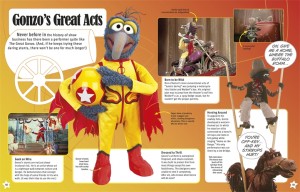 TP: It’s definitely appreciated by the fans, those little tidbits.
TP: It’s definitely appreciated by the fans, those little tidbits.
CS: I wrote this as a fan and as a person who is a Muppet writer. DK, they do children’s books. That’s what they do. They wanted this to be aimed at a children’s audience, and both Jim Lewis and I felt strongly that it should be aimed at a Muppet audience. We assured them there won’t be anything bad for children in it. There may be some jokes that they don’t understand, but even if they don’t understand what they mean, they’ll be silly jokes, and they’ll be things that children will enjoy even if they can’t appreciate them.
I did a few sample pages, I think Camilla was one of the first ones. They needed a few pages to show at the various book conventions for presale. So we did a few pages, and once they saw where we were headed, and when Disney also agreed that that was the approach, I felt much better about where we were going.
TP: What was the process of writing it?
CS: We started out with something they called a synopsis. I gave them a list of characters, and with each character there were a few sort of “special moments” that we would try and highlight. Under Gonzo there would be a thing about Gonzo’s first date with Camilla. Basically just a few bullet points about what these moments were and what they were from.
I think they wanted 190 Muppets in that summary, and I think I gave them 200. Then they went through that and sort of winnowed away some of the characters for various reasons until we got to the list of the characters that we were going to be going with. The DK designers, who I think did a really nice job on this, did the page layout, and they showed me what the sample page was going to look like, and they gave me some word counts for the various fields. So I could start working on stuff, and then they would send me batches of pages with the photos in. Sometimes there were some dummy things, where they hadn’t gotten all the photos yet, and I would write to the images.
TP: So they found the photos.
CS: They found the photos. There is a big storehouse of photography that Henson had sent over when they sold the characters, and for many years no one knew exactly what was in it. For this, Disney decided to scan a lot of stuff that was sitting in boxes. There’s stuff in there from Muppet Magazine… There’s some stuff I’m glad they found, like the picture of the camel with Statler and Waldorf.
Because they didn’t have access to all the Muppet Shows, I sent them some reference material for The Muppet Show, and then they would contact Disney for certain images. Certain characters, I believe, were eliminated because there was a problem sourcing images. Gaffer was a character they didn’t have quality images of. They didn’t want to use frame grabs unless they absolutely had to. I think they figured that on a character like Gaffer, who really didn’t have much to do, it would have been very hard to make a good-looking page.
There were characters that were eliminated because Disney felt that they were not relevant to the audience that they were trying to sell to. They’re developing a new group of Muppet fans as well as catering to the existing ones. Then there were characters that were eliminated for, shall we say, legal reasons.
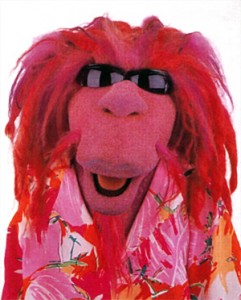 TP: Would that include the Jim Henson Hour characters?
TP: Would that include the Jim Henson Hour characters?
CS: The Jim Henson Hour characters, with the exception of Clifford and Bean — Bean is really an earlier character — they felt that since the characters only appeared on that one show and didn’t really continue, they [would be excluded]. Clifford would make it because he kept going, but some of the other ones like Lindbergh, they were all in my original list of characters.
TP: With that logic, why were there some of the Muppets Tonight characters, like Jowls? That seemed like such an odd choice.
CS: I think they may have thought there were some legal ownership issues with some of that. I worked from a list I had gotten from Disney Legal, which was an exhibit from the sale of the characters, which listed all of the characters that Disney owned. I knew that Disney owned these characters.
There were some problems with some of the characters, like the ad agency frogs. While Disney owns the characters, the film is not owned by Disney, so there was a concern by some about using images from that film. For reason or another, and because we were on such an accelerated schedule, they didn’t want to try and make the call and get permission. We were also going to include Swamp Years characters, and that was also a problem, because Sony owns that show even though the characters are still owned by Disney.
TP: So how did the Sam & Friends characters make it in?
CS: Sam & Friends are owned by Disney, but they reside in a world of frozen properties, so they can’t use them unless Henson gives them permission. I believe Henson gave them permission, but if you’ll notice, the picture that’s used is from the 30th anniversary show, which is owned by Disney. I think if they did not find that picture, they probably would have cut Sam & Friends because they wouldn’t have wanted to get permission to use photos that they didn’t own.
Stay tuned for one more installment of great info and stories from Craig Shemin! Click here to mistake Muppy for Rufus on the Tough Pigs forum!
by Ryan Roe – Ryan@ToughPigs.com

